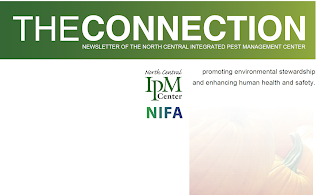Last week Clyde, Barb, our UNL videographer and I went to an apartment to stage a mock bed bug inspection for an interactive video project. We walked through all the steps of what someone might do to check for and treat for a bed bug infestation, including many IPM strategies. I will highlight some of these steps here.

One of the first things to do is inspect in and around the bed by taking down the bedclothes and checking the bedspread, pillowcases, sheets, and mattress pad. These should then be put into a large plastic bag, carried to the laundry room, and washed and dried.
Next, inspect the mattress, especially around the seams. You should also look at the box springs, including removing the dust cloth. In addition, remove the headboard if possible, check behind picture frames above the headboard, and pull the bed away from the wall.
Besides the bed, you should look at drawers, cracks and crevices, and other potential hiding places within the infested room. Couches and recliners are also good bed bug harborage locations.

After examining the mattress, you can put bed bug encasements on the box springs and mattress, which prevents any bed bugs that are already on the bed from getting out and feeding on you at night. It also prevents new bed bugs from getting into the seams of the mattress and in and under the box springs.

To prevent bed bugs from other locations from crawling up the bed posts, you can install "intercepters," which are little plastic devices that can be placed under bed posts at night. Bed bugs can crawl up these, but then fall into a "pit" that they are unable to get back out of. This is good for monitoring the bed bug population and an additional benefit is capturing bed bugs that otherwise would be feeding on people!

In addition to a human inspection, you may choose to hire a bed-bug sniffing dog! These dogs are trained to hone in on the scent of live bed bugs and can find bugs that a human may not. In our video we featured "Spots," a rat terrier from Nebraska's
K9 Bed Bug Detection. According to his handler, Spots is 95% accurate in finding bed bugs, where humans average 30-40%. After putting some "scent" from bed bugs in the couch and the bed, we watched as Spots did his job, and he hit on these areas very accurately!

If there is a heavy infestation, pesticide application may be necessary. Some low toxic products, such as diatomacheous earth, can be placed in hard to reach areas, such as behind electrical outlets. Pesticides such as DDT that were used in WWII and before to control bed bugs have been banned due to the health risks to humans. Research is being done to find new treatments, as bed bugs have shown resistance to a lot of chemistry that used to successfully control them. In our video we spoke with a PMP, who explained inspection and treatment options for a homeowner dealing with bed bugs. With the resurgence of bed bugs, more PMPs are responding to calls about this pest and serving as educational resources. They are using a combination of techniques, including not only what has been mentioned here, but also vaccuming, steam, and heat treatments.
To read more about bed bugs, check out this article from the
Lancaster County Extension Office. You can also view more photos of our mock inspection from our
PSEP Facebook page.
NOTE: No live bed bugs were harmed during the filming of this video :-) We only used ones that were already dead!


















































